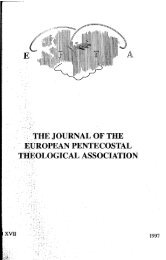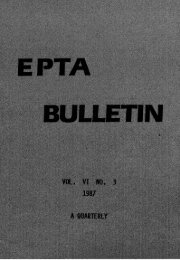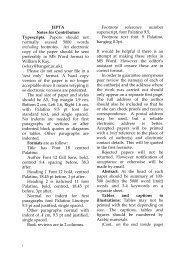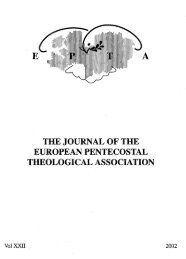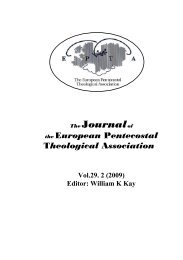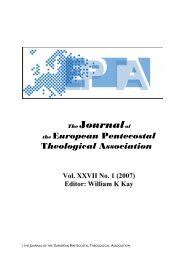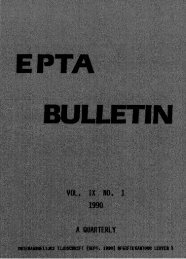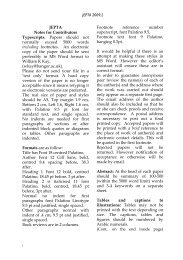jepta 2001 21 - European Pentecostal Theological Association
jepta 2001 21 - European Pentecostal Theological Association
jepta 2001 21 - European Pentecostal Theological Association
Create successful ePaper yourself
Turn your PDF publications into a flip-book with our unique Google optimized e-Paper software.
The Journal of the <strong>European</strong> <strong>Pentecostal</strong> <strong>Theological</strong> <strong>Association</strong>, Vol. XXI, <strong>2001</strong><br />
Ephesians 4:4 makes reference to the Church as I believe it does when it says that<br />
there is "one Body," then it doesn't get any clearer than that. There is only one<br />
Church and Christ Jesus is its head. But what kind of church is it<br />
There are many ways in which we could go, but as I read the New Testament I<br />
am struck by how tangible and material are the descriptions of the Church. It is<br />
not that the Church is not a spiritual reality - it is. But the New Testament knows<br />
nothing of a Church that is completely invisible. The Church in the New<br />
Testament is always represented as people with names and addresses. Thus the<br />
Apostle writes, "To all God's beloved in Rome, who are called to be saints<br />
(Romans 1:7)." He writes "to the church of God which is at Corinth (1<br />
Corinthians 1:2) or "to the church of God which is at Corinth, with all the saints<br />
who are in the whole of Achaia (2 Corinthians 1 : lb)." He writes "to the churches<br />
of Galatia (Galatians 1:2b)," as well as "to all the saints in Christ Jesus who are at<br />
Philippi, with the bishops and deacons (Philippians I : lb)." Likewise, he writes<br />
"to the saints and faithful brethren in Christ at Colossae (Colossians 1:2)" as well<br />
as "to the church of the Thessalonians (1 Thessalonians 1 : 1 b and 2 Thessalonians<br />
1 : lb)." But if mention of Christians in a given geographical region or a named<br />
city isn't sufficient to demonstrate the visible, material, tangible character of the<br />
Church in the New Testament, we need only think of the Apostle's work<br />
concerning Onesimus the slave. In this letter, Paul writes "to Philemon our<br />
beloved fellow worker, and Apphia our sister and Archippus our fellow soldier,<br />
and the church in your house (Philemon 2)." Paul, it seems, did not think of the<br />
Church in terms of any visible/invisible dichotomy. He thought of the Church in<br />
material and tangible terms. He wrote to individuals and to groups that gathered<br />
in real places, with published street addresses. He didn't write to the church at<br />
Rome, and then drop the letter at the city limits and wait to see who picked it up.<br />
He had a specific group of people in mind in each place.<br />
For me to argue the materiality of the Church from the New Testament is not to<br />
deny that it can also be argued from the New Testament that Paul thought and<br />
spoke about the Church in more "mystical" terms as well. When we read his<br />
metaphors about the Body of Christ or the Bride of Christ or the Family of God,<br />
we have transcended the visible reality of a simple collection of Christians who<br />
gather at a specific street address. After all, the Body of Christ is not complete<br />
only in the local community, though in some ways it might be. It is complete<br />
only when all Christians are viewed as part of the Body of Christ. But a body<br />
without a head is an incomplete picture, so the Apostle notes that the Head of the<br />
Church is Jesus Christ.<br />
As we look at the Church from another angle, we must note that whether it is the<br />
congregation in Philemon's home or an unnamed group of people meeting in an<br />
unspecified place in the city of Rome or Thessalonica, the metaphor of the Body<br />
of Christ is a way of describing the Church in its universality. In a sense, the<br />
Body of Christ is not complete unless we take into account all the "saints," past,<br />
Roman Catholic-<strong>Pentecostal</strong> Dialogue:Some <strong>Pentecostal</strong> Assumptions:<br />
Cecil M. Robeck, Jr.<br />
present, and future, that is, dead, living, and yet unborn. If many of these people<br />
are unknown to us by name, or they are known to us only in some mystical sense,<br />
that does not in any way negate the fact that we are still speaking about real<br />
people who have been, are, or will be known by others and who are now in a<br />
sense, known only by God. The Church is a physical, material presence in our<br />
reality, but it extends far beyond that.<br />
It is precisely because the Church is not merely an invisible, spiritual reality that<br />
the Apostle begs the Ephesians to live a life worthy of their calling. The life for<br />
which he calls includes an eagerness "to maintain the unity of the Spirit in the<br />
bond of peace (Ephesians 4: 1-3)." I suppose we could argue about the nature of<br />
the genitive tou pneumatou', that is, of the Spirit, but my vote is to look at this<br />
thing as that which the Spirit has created, the fellowship in or of the Spirit, which<br />
is the Church, and to realize that in some sense, we are called to maintain the<br />
unity of that thing that the Spirit has created, and to do so "in the bond of peace."<br />
If this is what Ephesians 4:l-6 is about, then we must come to terms with two<br />
concepts that have come down to us through history. The first is the concept that<br />
the true Church exists within the larger church. The Montanists provide us with a<br />
clear example of this model. Here, names could be attached to those who were<br />
part of both groups. They were identifiable. Everyone knew where he or she fit,<br />
and they called each other names. There were the pneumatikoi and the others<br />
were the pseuchichoi. There were the "spiritual" ones, and there were those who<br />
were not.' Does this not sound like there were those who held something like the<br />
"Full Gospel" over the heads of others<br />
In the second case, we are introduced to spiritual and material realities. In this<br />
case, it is Augustine who points the way. When he looked at the post-<br />
Constantinian Church around him, he realized that the Church he surveyed<br />
looked quite different from the one about which he read in the New Testament.<br />
There were people who claimed the name "Christian" who, in Augustine's mind,<br />
were not "Christian" by the standards of the New Testament. As a result, to<br />
describe the Church, he drew from Jesus' parables of the wheat and tares<br />
(Matthew 13:24-30) on the one hand, and the good and bad fish that were caught<br />
by the same net (Matthew 13:47-48) on the other. The wheat and the good fish<br />
were obvious references to the righteous - remember these parables provide us<br />
with pictures that are analogous to the Kingdom of the Heavens - or in<br />
Augustine's mind, the Church. The field of wheat and tares, and the net with<br />
both good fish and bad fish came to be identified as Christendom.'<br />
' Tertullian, Treatise on the Soul 9.3-4; D. Powell, "Tertullianists and Cataphrygians," Vigiliae<br />
Christiame 29 (1975), 33-54.<br />
' Augustine, City of God, passim; On Baptism Ill. xix. 26.




